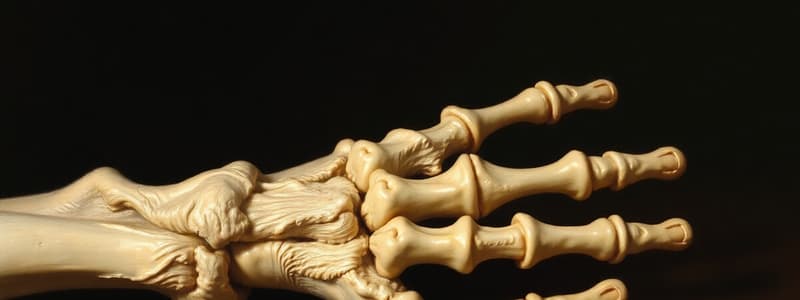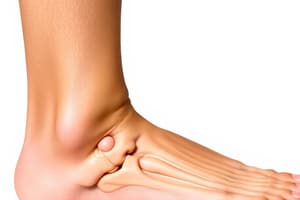Podcast
Questions and Answers
What is the primary role of sesamoid bones in the body?
What is the primary role of sesamoid bones in the body?
- To increase the range of motion of joints
- To store fatty acids in bone marrow
- To aid in the detoxification of heavy metals
- To protect tendons from wear or stress (correct)
Which of the following best describes one of the functions of bones?
Which of the following best describes one of the functions of bones?
- Transport oxygen throughout the body
- Absorb and store heavy metals from blood (correct)
- Regulate blood pressure during rest
- Increase the flexibility of joints
Which of these minerals is primarily stored in bones?
Which of these minerals is primarily stored in bones?
- Iron
- Potassium
- Calcium (correct)
- Sodium
How do bones contribute to movement in the body?
How do bones contribute to movement in the body?
What process do bones undergo to raise or lower calcium levels in the blood?
What process do bones undergo to raise or lower calcium levels in the blood?
What vital organ is protected by the skeletal system?
What vital organ is protected by the skeletal system?
What type of blood cells are developed in bone marrow?
What type of blood cells are developed in bone marrow?
Which of the following is NOT a function of bones?
Which of the following is NOT a function of bones?
What is the primary process that begins embryonic skeletal development?
What is the primary process that begins embryonic skeletal development?
At what age is bone development typically considered complete?
At what age is bone development typically considered complete?
Which type of ossification transforms fibrous membranes into bone?
Which type of ossification transforms fibrous membranes into bone?
What percentage of bone structure is compact bone?
What percentage of bone structure is compact bone?
Which part of the skeleton is primarily formed through endochondral ossification?
Which part of the skeleton is primarily formed through endochondral ossification?
Which tissue primarily forms the precursor for intramembranous ossification?
Which tissue primarily forms the precursor for intramembranous ossification?
What is the primary function of cancellous bone?
What is the primary function of cancellous bone?
How does endochondral ossification occur?
How does endochondral ossification occur?
What is the purpose of bone ossification during development?
What is the purpose of bone ossification during development?
What initiates the growth of the embryonic skeleton?
What initiates the growth of the embryonic skeleton?
What is the first step that occurs after blood vessels rupture during bone healing?
What is the first step that occurs after blood vessels rupture during bone healing?
Which cells primarily contribute to the formation of a soft callus during the bone healing process?
Which cells primarily contribute to the formation of a soft callus during the bone healing process?
During which stage does the soft callus become mineralized?
During which stage does the soft callus become mineralized?
What combination of elements causes the soft callus to harden during the healing process?
What combination of elements causes the soft callus to harden during the healing process?
What type of cells are involved in laying down the cartilage during the bone healing process?
What type of cells are involved in laying down the cartilage during the bone healing process?
What is the primary function of osteoclasts?
What is the primary function of osteoclasts?
Which component makes up the largest percentage of fully developed bone?
Which component makes up the largest percentage of fully developed bone?
Which statement about bone tissue is true?
Which statement about bone tissue is true?
What role do osteoblasts play in bone maintenance?
What role do osteoblasts play in bone maintenance?
How often does the body destroy old red blood cells through bone activity?
How often does the body destroy old red blood cells through bone activity?
What type of tissue is bone classified as?
What type of tissue is bone classified as?
Which of the following is not a component of bone?
Which of the following is not a component of bone?
What is the main function of collagen in bone?
What is the main function of collagen in bone?
What is the composition of fully developed bone in terms of water percentage?
What is the composition of fully developed bone in terms of water percentage?
What is the significance of the balance between osteoblast and osteoclast activity?
What is the significance of the balance between osteoblast and osteoclast activity?
What type of cell produces osteoid which is later mineralized to create bone?
What type of cell produces osteoid which is later mineralized to create bone?
What are osteoclasts primarily responsible for in bone structure?
What are osteoclasts primarily responsible for in bone structure?
What is the primary function of osteocytes?
What is the primary function of osteocytes?
During ossification, where does bone formation start?
During ossification, where does bone formation start?
What happens to active osteoblasts during bone development?
What happens to active osteoblasts during bone development?
What is the role of cranial sutures in bone structure?
What is the role of cranial sutures in bone structure?
Which type of bone cells are known for repairing old bone?
Which type of bone cells are known for repairing old bone?
What occurs throughout a person's life regarding bone structure?
What occurs throughout a person's life regarding bone structure?
What is the characteristic of immature bone cells?
What is the characteristic of immature bone cells?
Which structure does cartilage transition to during bone development?
Which structure does cartilage transition to during bone development?
Flashcards are hidden until you start studying
Study Notes
Tissues
- Sesamoid Bones: Small bones embedded in tendons, typically located near joints; an example is the patella (knee cap).
- Function: Protect tendons from wear and stress.
- Calcium Balance: Bones regulate blood calcium levels by forming bone (increasing calcium) or undergoing resorption (decreasing calcium).
Functions of Bone
- Protection: Safeguard vital organs like the heart and brain, preventing damage.
- Shape: Provide a framework that supports the body structure; bones work with joints, ligaments, tendons, and muscles for movement.
- Movement: Depend on muscles anchoring to bones for mobility.
- Blood Production: House the development of red and white blood cells, producing platelets; the bone marrow destroys old or defective red blood cells.
- Mineral Storage: Serve as reservoirs for minerals (calcium, phosphorus) and store fatty acids in bone marrow.
- Endocrine Function: Produce precursors for hormones that influence growth and brain development.
Bone Development
- Ossification: Bone formation begins before birth; complete by roughly age 25.
- Types of Ossification:
- Intramembranous Ossification: Forms flat bones, such as in the skull, starting from a fibrous membrane.
- Endochondral Ossification: Replaces cartilage with bone.
Bone Structure and Composition
-
Types of Bone:
- Compact Bone: Accounts for approximately 80% of bone mass.
- Cancellous Bone: More porous, found at the ends of long bones.
-
Cells in Bone:
- Osteoblasts: Responsible for forming new bone; produce osteoid, which mineralizes to become bone.
- Osteocytes: Mature bone cells that facilitate communication within bone tissue and originate from trapped osteoblasts.
- Osteoclasts: Cells that break down bone, releasing enzymes and acids to remodel injured bone; maintain the optimal shape of bone.
-
Mineral Composition:
- Inorganic Material: Contains 40-50% calcium phosphate.
- Organic Material: Contains 30-40% collagen.
- Water Content: Comprises about 20%.
Bone Healing Process
- Stages:
- Formation of a haematoma after injury.
- Development of a soft callus, where osteoblasts lay down osteoid and chondrocytes contribute cartilage.
- The soft callus mineralizes as calcium and phosphate harden it.
- Healing duration: Soft callus becomes hard in about 2-12 weeks.
Additional Notes
- Bone is a vascular tissue, exhibiting significant growth capacity especially in the first two decades of life.
- Bone remodeling and regeneration occur throughout life, crucial for maintaining bone health and integrity.
Studying That Suits You
Use AI to generate personalized quizzes and flashcards to suit your learning preferences.




